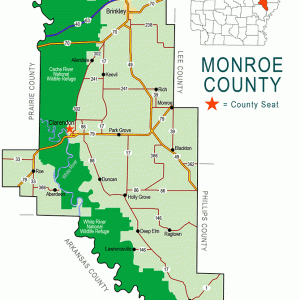calsfoundation@cals.org
Indian Bay (Monroe County)
Indian Bay is an unincorporated community in southern Monroe County. Located on a lake of the same name, Indian Bay lies within the White River National Wildlife Refuge.
The area of Indian Bay has long been inhabited, as is shown by nine Native American mounds nearby, the largest of which covers more than an acre. Artifacts found in the area are thought to be 1,300 to 1,700 years old, but the site is not open to the public.
According to official records, the settlement that became Indian Bay was surveyed around 1825, at which time the community was called Warsaw. John Diana was the first landowner in Indian Bay. He was joined by Moses Price, Joseph Mitchell, A. Berdu, Major Dukes, and Samuel Black, all of whom acquired land in the area before the Civil War. Another source mentions the names of James and Robert Jackson, Robert Smalley, William J. Edwards, and others as “pioneer settlers” of the township. The first store was opened by Black in partnership with M. D. Martin; the two men also owned and operated a cotton gin and a sawmill. Cypress logs were harvested from the area and floated downstream as rafts. William Mayo arrived in the area around 1853, bringing a large number of slaves and developing a plantation of several thousand acres. Indian Bay was a prominent stop for steamboats coming up the White River from Memphis, Tennessee. A post office opened at Indian Bay in 1860.
During the Civil War, Samuel Black served under General Patrick Cleburne and was eventually promoted to major. The community of Indian Bay was reached by Federal forces in the White River Expedition of February 1864. A skirmish was fought at Indian Bay on April 13 of that year, involving the Fifty-sixth U.S. Colored Infantry. Following the war, the community received notoriety with the nearby shooting of James M. Hinds, a U.S. Congressman from Arkansas, on October 22, 1868.
Construction of a levee on the east bank of the Mississippi River around 1882 changed the water flow of eastern Arkansas, leading to several White River floods in the following years. By 1890, many residents had left the Indian Bay area. The area still contained three general stores, two cotton gins, grist mills, and sawmills, and had a small population, according to the Goodspeed account of Monroe County. Around this time, the Brinkley, Indian Bay, and Helena Railroad was completed through the region, used largely to transport timber to market. Much of the remaining population was African American, as is shown by local participation in the Universal Negro Improvement Association in 1924. The population decline continued, however, and the post office was closed in 1932, with mail sent to Holly Grove (Monroe County). Since that time, the Indian Bay area has been largely associated with fishing and with duck hunting.
For additional information:
Biographical and Historical Memoirs of Eastern Arkansas. Chicago: Goodspeed Publishing Company, 1890.
McKinney, Watt. “Indian Bay.” Phillips County Historical Quarterly 9 (March 1971): 18–24.
Steven Teske
Butler Center for Arkansas Studies
 Monroe County Map
Monroe County Map 




Comments
No comments on this entry yet.